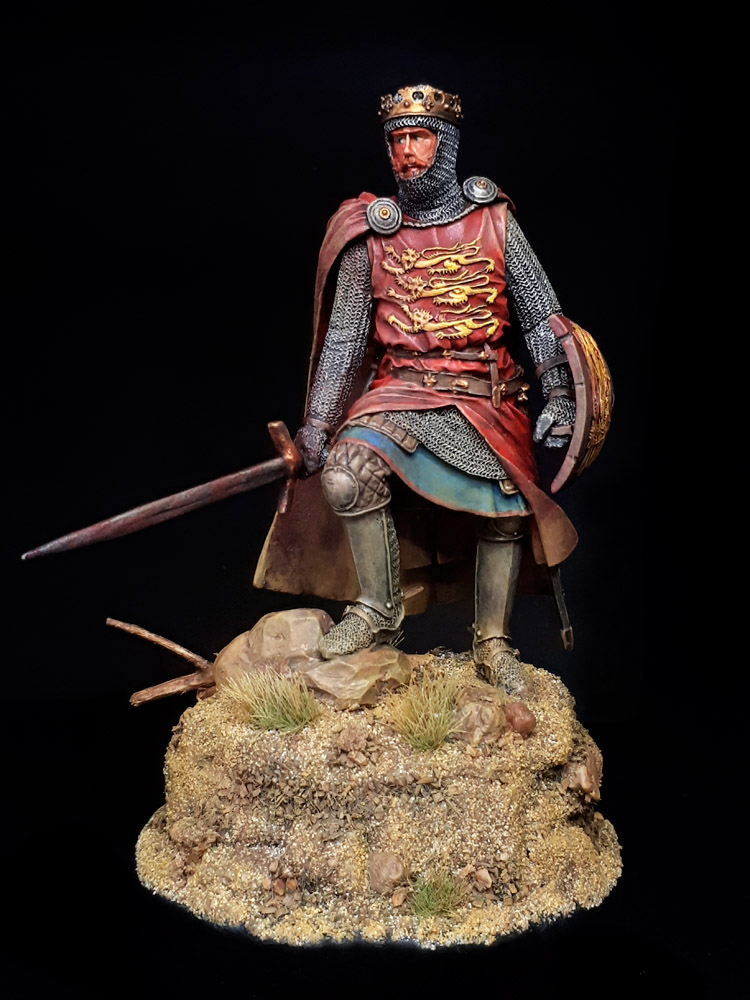
Richard I was King of England from 1189 until his death in 1199. He also ruled as Duke of Normandy, Aquitaine and Gascony, Lord of Cyprus, and Count of Poitiers, Anjou, Maine, and Nantes, and was overlord of Brittany at various times during the same period.
He was the third of five sons of King Henry II of England and Eleanor of Aquitaine and seemed unlikely to become king, but all his brothers except the youngest John, died before their father. Richard is known as the Lionheart because of his reputation as a great military leader and warrior. ‘The Itinerarium peregrinorum et gesta regis Ricardi’, a Latin prose narrative of the Third Crusade, states that: “He was tall, of elegant build; the colour of his hair was between red and gold; his limbs were supple and straight. He had long arms suited to wielding a sword. His long legs matched the rest of his body”.
He was born in England, where he spent most of his childhood. By the age of 16, Richard had already taken command of his own army, putting down rebellions in France against his father. After he had been crowned king, he spent very little time, perhaps as little as six months, in England. Most of his life as king was spent on Crusade, in captivity, or actively defending his lands in France.
He was a Christian commander during the Third Crusade, leading the campaign outright after Philip II of France departed due to ill health and following a dispute with Leopold of Austria, Richard’s men tore his flag down and threw it in the moat of Acre, Leopold left the crusade immediately.
He achieved considerable victories against his Muslim counterpart, Saladin, although he failed to retake Jerusalem. He and Saladin finally came to a settlement on 2 September 1192. The terms allowed Christian pilgrims and merchants access to Jerusalem, and initiated a three-year truce. Richard left for England on October 9, 1192.
On route home from the Third Crusade, Richard sailed from Corfu with four attendants, but his ship was wrecked near Aquileia in Italy, forcing Richard and his party into a land route through central Europe. On his way to the territory of his brother-in-law ‘Henry the Lion’ (a powerful German prince), Richard was captured shortly before Christmas 1192 near Vienna by Leopold of Austria and held prisoner. Richard had personally offended Leopold by casting down his standard from the walls of Acre during the crusade.
In 1193 Richard was handed over to Holy Roman Emperor Henry VI, who imprisoned him in Trifels Castle Germany. Henry VI was annoyed by the support the Plantagenets (Richards family) had given to the family of ‘Henry the Lion’ and by Richard’s recognition of ‘Tancred’ as king in Sicily.
After much negotiation and a huge ransom paid, on 4 February 1194 Richard I was finally released. Much to the chagrin of his brother prince John who with the aid of Philip of France had taken control of the kingdom in his absence. Including Philips conquest of Normandy. On his return Richard forgave John when they met again and named him as his heir in place of their nephew, Arthur. At Winchester, on 11 March 1194, Richard was crowned a second time to nullify the shame of his captivity.
Richard began his reconquest of Normandy. Winning several victories over Philip. At Fréteval in 1194, just after Richard’s return to France from captivity and money-raising in England, Philip fled, leaving his entire archive of financial audits and documents to be captured by Richard.
At the Battle of Gisors in 1198, Richard took Dieu et mon Droit—”God and my Right”—as his motto (still used by the British monarchy today), echoing an earlier boast to Emperor Henry during his imprionment, that his rank acknowledged no superior but God.
During a siege of the castle Châlus-Chabrol, on 26 March 1199, Richard was hit in the shoulder by a crossbow, and the wound turned gangrenous. Richard asked to have the crossbowman brought before him, according to some sources the crossbowman turned out to be a boy. He said Richard had killed his father and two brothers, and that he had shot Richard in revenge.
He expected to be executed, but as a final act of mercy Richard forgave him, saying “Live on, and by my bounty behold the light of day”, he then ordered the boy to be freed and sent away with 100 shillings.
Richard died on 6 April 1199 in the arms of his mother, and thus “ended his earthly day.” According to one chronicler, Richard’s last act of chivalry proved fruitless when the infamous mercenary captain Mercadier had the boy flayed alive and hanged as soon as Richard died.
Rather than regarding his kingdom as a responsibility requiring his presence as ruler, he has been perceived as preferring to use it merely as a source of revenue to support his armies. Nevertheless, Richard I remains one of the few kings of England remembered more commonly by his epithet ‘The Lionheart’ rather than his royal number, and is an enduring iconic figure both in England and in France. The earliest surviving representation of a shield, displaying three lions is that on the Great Seal of King Richard I, which initially displayed one or two lions rampant, but in 1198 was permanently altered to depict three lions passant, perhaps representing Richard I’s principal three positions as King of the English, Duke of the Normans, and Duke of the Aquitaines.
